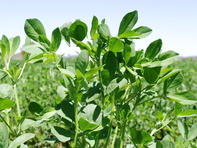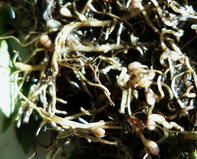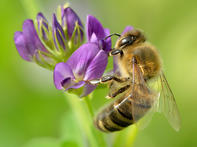Legumes are plants with taproots, produce seeds in pods and have compound leaves made up of smaller leaflets - think of peas and clover as examples.

Legumes are commonly used as a pasture crop. It can be sown on its own and used for grazing, cut for hay or harvested when green to be used for silage or haylage. Legumes as pasture crops increase the tastiness and protein content of livestock feed.
Often, legumes are mixed with grasses to produce a mixed pasture higher in protein and palatability than grasses alone. Any seed company will be able to advise on the best legumes and legume-grass combinations to grow in your area and on your soil type. Ask for guidance.
Advantages of Legumes as Pastures

When legume pastures are used as forage crops it produces more digestible protein for animals than grasses alone. Legumes have an added advantage in that it can transform nitrogen in the atmosphere to provide plant-soluble nitrogen to the soil through a process called ‘nitrogren fixing’.
This reduces the need to fertilise the pasture with nitrogen and benefits companion pasture plants. ‘Nitrogen-fixing’ is the result of a symbiotic relationship with soil bacteria called Rhizobium that forms small nodes on the legume’s roots. It is recommended that prior to planting, legume seeds should be inoculated with the suitable strain of Rhizobium bacteria to ensure node formation.
Other advantages of planting legumes as pastures are: Legume pastures are a high-quality source of animal feed and high in protein. Young, growing animals have a high protein requirement that can be met by including legumes in the forage mix. Legume pastures are tasty and with high digestibility, also increasing the calcium content in the crop.

Lucerne is an important forage for lactating dairy animals, although dairy farmers with irrigation might prefer clover-grass pastures. Legumes in the feed mix of lactating animals can increase the vitamin A and E and calcium intake of the animal and may increase the fat content in milk and overall milk quality compared to grass-only forages.
Many sheep farmers use nitrogen-fixing legumes such as Lucerne, clover and medics in their pastures to improve wool growth and quality. In Angora goats, too high protein levels may cause too ‘strong’ or thick hair fibres that can result in lower prices for their fibre. Studies showed improved conception rates and growth rates of beef cattle when legumes are used.
The yield of pasture increases when legumes are added in the pasture mix. In a study, red clover combined with tall fescue produced higher yields (10t/ha) than tall fescue fertilized with up to 165 kg nitrogen/ha (9 t/ha). Another study has shown the use of Lucerne and red clover is an acceptable alternative to fertilization of pastures.
Using legumes in a mix with grasses to create a biodiverse forage. It also improves the biodiversity of the farm, soil texture, can attract beneficial insects and improve the nutrient uptake from the soil.
Please note: Information is for educational and informational purposes only and may not be construed as planting, feeding or nutritional advice. For more information on feeding your animals or planting pastures contact your animal health technician or seed supplier.
By Marinda Louw